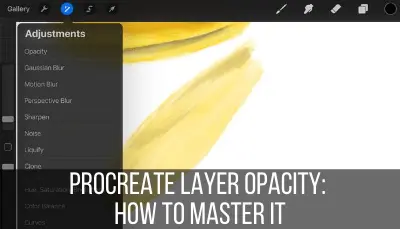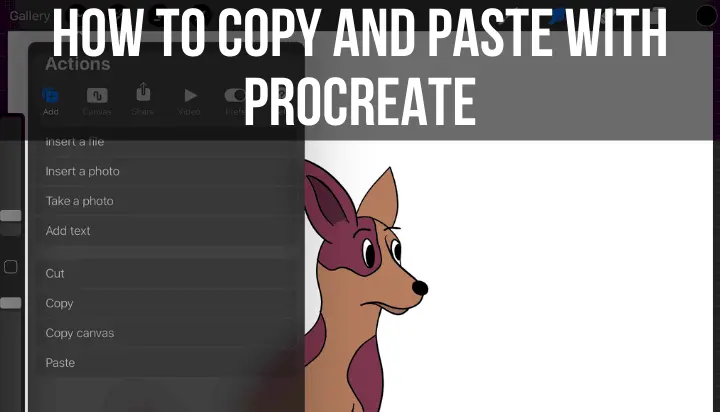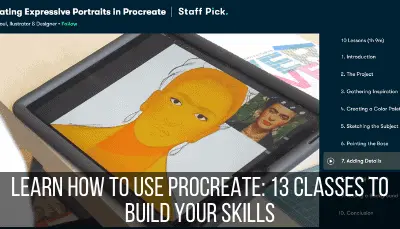In so many ways, technology has made our lives a lot easier. We can magically edit photos with one click, make designs from endless amounts of stock photos, and create beautiful pieces of art. Wait, wait, wait; that last one isn’t easy. Digital art is surprisingly hard. Maybe we love drawing with pencil and paper and think that will be an easy switch to the computer or iPad. Then, we’re sadly disappointed.
Digital art is so hard because it relies on a completely different skill set than traditional art does. Many skilled artists realize that they’re beginners again when they switch to a digital art platform and have to relearn the basics.
Making digital art can be really fun once you get the hang of it. Even though it’s challenging at first, the rewards for all of your efforts can be great.
Think back to the first time you held a pencil or a paintbrush and how far you’ve come since then. Digital art is the same way. After spending some time getting a strong foundation in digital art, you’ll be well on your way to enjoying this medium.
Let’s start off by talking about why the heck digital art is hard in the first place. Then, we’ll dive into ways that you can speed up the learning curve and jumpstart your digital art skills.
This post may contain affiliate links, which means I may earn a commission if you decide to purchase through my links.
Your Materials are Completely Different with Digital Art vs. Traditional Art
Obviously, you won’t be using paper, pencils, pens, and brushes for your digital art. Not in the traditional way, at least. Before you dive into digital art, it’s important to understand which tools you want to use and how to use them. If you’re like me, you love any excuse to buy new technology and play around with it.
This can be a downside though. Instead of grabbing some inexpensive paper and pencils, you have to shell out some serious money to even make 1 digital art stroke.
You also have to learn how the technology works before you’ll be able to get started with any art. All of this adds some complexity to the situation that you simply don’t have with traditional art.
Here are the types of technology you’ll probably be considering:
iPad and Apple Pencil: this is my go-to for digital art. I love the versatility of my iPad, and how I can use it for other purposes than art (though I use it for art most of the time!).
Important note: I know that a lot of people come to digital art wanting to use Procreate. It’s important to note that Procreate only works with iPads. We’ll talk about other drawing options aside from the iPad, but realize that they won’t work with Procreate. If you want to use Procreate, the iPad is the only option.
I have a post about getting whether it’s worth it to buy an iPad for the sake of Procreate that you can check out if you want to learn more about that!
I use a Bellemond matte screen protector with my iPad, which gives my iPad a textured surface that feels a lot like paper.
Given how precise and quick Apple Pencils are, they really do feel like traditional pencils. I’ve tried all of the other options on this list, but my iPad and Apple Pencil is what felt the most natural to me.

Drawing Tablet or Graphics Tablet: there are some tablets that connect to a computer, while there are others that have a screen that you can draw on – they look like iPads that are made just for digital drawing.
The prices on these vary widely depending on the tablet you choose.
Drawing/graphic tablets can be a good option, but realize that some of them may be tricky to use and require a computer and/or software.
They also can’t be used for purposes other than drawing.
I personally have the HUION 420 OSU tablet. It connects to my computer, which is where I see my drawing appear as I draw on the tablet. It was a learning curve for me, for sure.
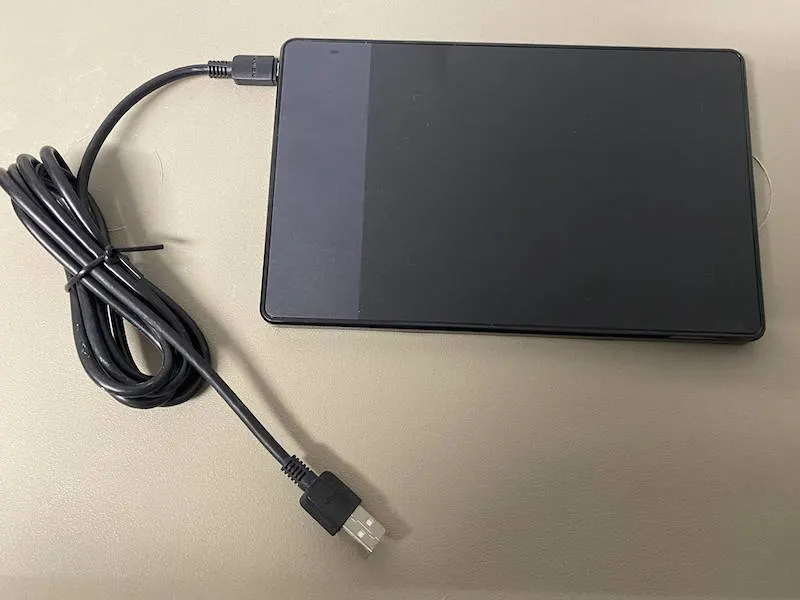
There’s also the XPPen Drawing Tablet that lets you draw directly on the screen if you’re looking for a higher end option.
As a reminder, these do not work with Procreate. Prior to purchasing, check the compaitble softwares and make sure you’re open to using them.
Computers: you can draw just with your computer. A lot of people do this with Adobe’s Illustrator using any type of laptop or desktop you have. Microsoft’s Surface Pro is a really interesting option in the digital art world though.
The Surface Pro is one of those computers that has a touchscreen and can be turned into a tablet at any time.
What I like about the Surface Pros is that they’re big, beautiful, and have the power of a computer in something that you can use as a tablet. The Surface Pro is a really cool choice for digital art, but like I said with the iPad option, it’s nice that you can use it for other things as well.
As a reminder, these do not work with Procreate. Prior to purchasing, check the compaitble softwares and make sure you’re open to using them.
After reading all of that, maybe you’re excited to buy a snazzy new piece of tech. Or, maybe you’re annoyed that there’s this extra hurdle you have to jump over to even get started with digital art.
Whichever camp you fall in, there’s no doubt that diving into the tech side of things is a necessary part of digital art that just isn’t there with traditional art. Depending on how tech savvy you are, this can add a varying degree of challenge to your digital art life.
A Lot of Techniques Don’t Function the Same Way with Digital Art vs. Traditional Art
When you learn traditional art you figure out how to shade, color, crosshatch, stipple, and blend your materials on your paper. It takes some time, but you get the hang of it. You switch over to digital art and expect things to work the same way, but they don’t.
Maybe you hop onto YouTube and watch some tutorials and get totally confused by the techniques they’re using. Why are they shading that way? How did they make those colors so vibrant? Things look so different in the digital world than they do in the traditional one.
A lot of digital artists use things like layers, opacities, and hex codes to achieve their shading, blending, colors, and other artistics effects. Basically, they use the tech to their advantage. When you’re just getting started, this can be REALLY tricky.
Instead of just rubbing your pencil lines to get the shading you’re looking for, you create a bunch of layers with different colors that all lay on top of each other in a certain way. Yeah, it can be a lot.
A lot of these techniques are complicated, but they’re also what makes digital art so distinct. It’s why you can look at a piece of artwork and feel like it’s glowing or that the colors pop in a certain way. In a lot of ways, these techniques are what make digital art so special.
But, like all art, digital art can be whatever you want it to be.
There are a lot of complicated things that you can do with digital art platforms. At the end of the day though, it’s just another canvas that’s open to your imagination. Learn some complicated techniques, or don’t. It’s your choice. Just make art you like.
It’s also important to be clear that you CAN use the same principles for shading, blending, and color mixing on a digital platform as you would traditionally. Actually, this is what I do most often with Procreate.
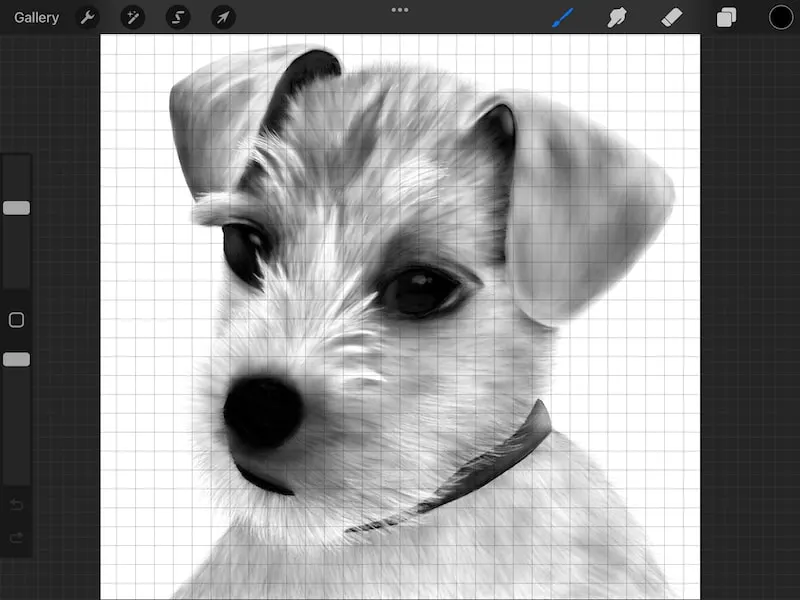
I love shading with paper and pencil and wanted to figure out how to do that digitally. With a little trial and error, I was able to replicate the same effect and feeling I get from traditional shading with my digital shading. I do experiment with Procreate’s more advanced features, but I’m a happy camper with my digital shading.
I have a full guide about shading with Procreate that you can check out if you want to learn more!
Digital Art IS Easier Than Traditional Art for Certain Things
Digital art is easier than traditional art when erasing, resizing, undoing, copying, pasting, coloring, and animating your work. With traditional art, you are limited to what’s in front of you. With digital art, you can make grand changes to your art and canvas in just a few seconds.
It’s a HUGE luxury to be able to erase and change your canvas as much as you’d like on your iPad or tablet. I used to get so stressed out making traditional art because it felt so permanent.
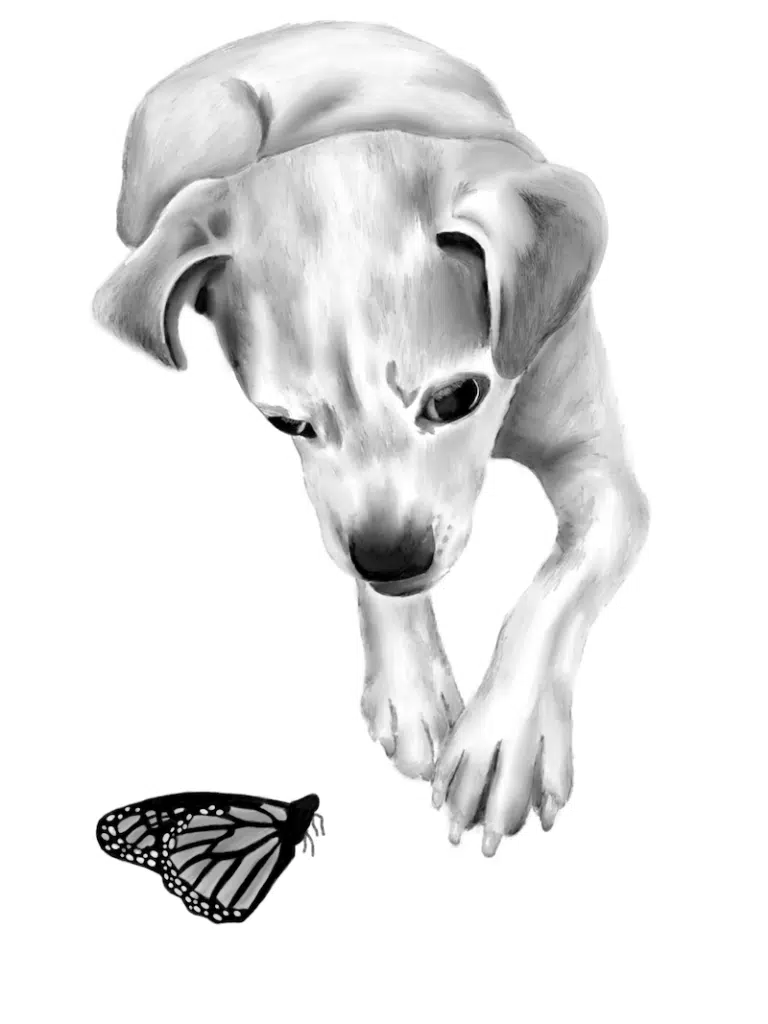
What if I wanted to experiment or test something out? What if I made a mistake, which I seemed to do ALL the time?
Well, there’s no need to worry about that with digital art! By default, this makes digital art easier than traditional art in these important ways. In the question of whether digital art is easier than traditional art, these are important factors to consider:
- instantly erase without leaving any marks
- undo anything you need to
- instantly copy and paste any part of your work to a whole new canvas
- instantly change your pencil, pen, or brush to an almost endless amount of choices
- instantly choose any color you can imagine
- use a number of different “mediums” in your work without having to get any more supplies or tools
- make certain parts of your work invisible while you work on other parts
- completely start over with parts of your work
- animate your cartoons
- resize and crop your canvas
This is just a short list. As someone who hates stray pencil lines and making mistakes, these things are really cool. The ability to erase things alone would keep me using Procreate.
That said, you still need to learn how to use all of these features and make the most of them. It’s yet another thing to learn when you switch to digital art.
All of these features don’t necessarily make digital art more difficult than traditional art, but it does force you to think outside of the box, which can naturally be more difficult. When you dive into digital art, you’ll want to spend some time understanding everything that it can do.
If you don’t, you can still use the platform, but you’ll be missing out on a lot of what makes it so great.
At the end of the day, technology is a lot more complex than a piece of paper. From my experience, you’ll love all of the horsepower and available features once you figure them out, but it’s difficult at first. Tech comes with as many challenges as it does perks.
Go in with the mindset that you’ll need to learn the tech along with the art before you get started and you’ll make your life a lot easier.
You Need a Different Understanding of Colors for Digital Art vs. Traditional Art
Digital art platforms like Procreate give you access to almost any color you can think of. If it has a hex code and can be found on the color wheel, it’s fair game.
This means that you’ll want to expand your knowledge of colors. Maybe you want pink, but what shade exactly? There are endless numbers of them. Maybe you want black, but how dark and rich? There are a lot of different ways to adjust the opacity.

With digital art, gone are the days of mixing red and blue to make purple. That said, there’s a different struggle when you realize that you have so many different shades to choose from.
To be clear, you don’t NEED a huge education in colors to get started with digital drawing. Procreate, for example, has a bunch of pre-made palettes you can use based on different tones and moods. You can also just choose colors from the wheel without being overly particular about the exact hue.
But, it’s really easy to get overwhelmed and to dive into a rabbit hole of all of the color options that Procreate can make possible for you. Color matching; creating color palettes from photos; there’s so much Procreate can do!
To make the most out of your digital art experience, you’ll want to play around with colors and start to understand how they work on your digital platform.
Yes, red and blue make purple, but how do you choose the exact right purple now that you have an endless number of them? How do you manipulate it to get your highlights and your shades just right?
When I first started with digital coloring, my hues were all over the place and a complete mess. I would choose a purple that was too bright and then darken it too much to make a shadow out of it and somehow turn it into a strange pink color when I went ahead to make the highlight. Ay caramba.
What’s really cool about digital art platforms is that you have access to an endless amount of colors for the price of the platform. For Procreate, that’s only $10. You don’t have to spend a lot of money on expensive art supplies that only give you 8 colors to mix from. That’s a HUGE benefit of digital art over traditional art, but it does come with a learning curve.
Brushes, Pencils, and Pens Act Differently on a Digital Platform
Digital art platforms like Procreate are absolutely incredible given how realistic their brushes, pencils, and pens are. I’ve done tons of digital artwork that looks like it could have been done traditionally. Experimenting with all of the different tools and seeing what they can do is one of my favorite pastimes.
Did you know that Procreate has a brush that can instantly make clouds? See, their brushes are really cool.
Even though Procreate does a great job replicating different types of brushes, there are just certain things that can’t be done digitally.
For example, the texture of acrylic paint is something that many painters know and love. Procreate’s acrylic tool can’t give you those luscious clumps of paint you get with a heavy brush stroke, nor can it give you that same shine.
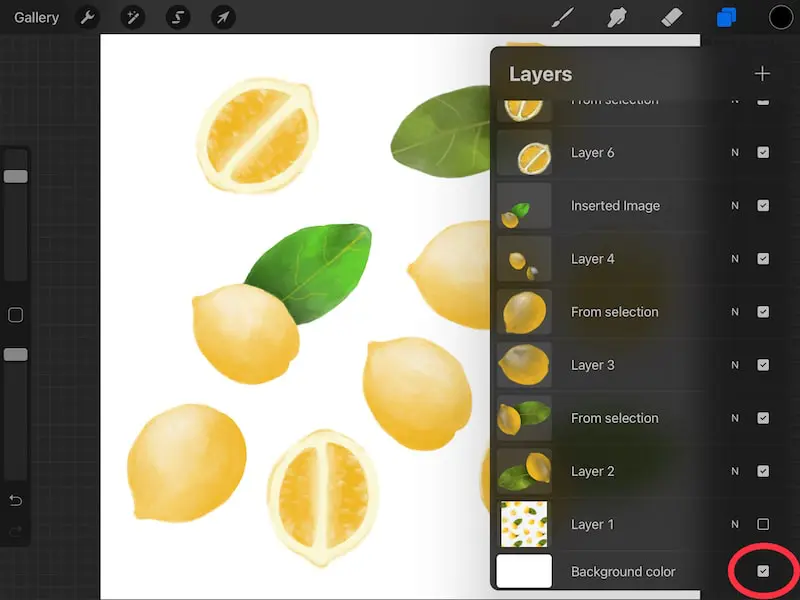
To be fair, Procreate’s acrylic brush is one of its weakest, in my opinion. Their watercolor paint brush is pretty spot on though and all of their pen and pencil options are extremely accurate.
When using the paint brushes, you’ll need to get used to the fact that you don’t have access to water. Instead of making a lighter watercolor wash by adding water, you’ll be toying around with the brush opacity and the amount of pressure you put on your stylus.
This can take some getting used to. I was also surprised by how light the first stroke of the acrylic brush is. There’s definitely a learning curve with using digital art tools, especially paint brushes.
Aside from your materials looking different on your digital canvas than they would in real life, you also need to realize that all of your tools, regardless of whether it’s a paintbrush or a piece of charcoal is being manipulated through your stylus. I don’t know about you, but I hold charcoal differently than I do a paint brush.
It’s not only necessary from a logistics standpoint, it also creates different effects. Laying the charcoal on it’s side and sweeping it across the paper can make a nice, gravel background texture. Flicking a paint brush can give a nice flair to the end of a line. You can’t do these things with a stylus.
With digital art, you’ll need to figure out how to make a lot of different effects with a lot of different tools, all while using the same stylus that you’re consistently holding in the same way. Styluses, especially the Apple Pencil, are really great.
That said, they aren’t great enough to let you use the side of it or hold it in any type of creative way. You have to make sure that the point is touching your digital canvas. This can make it tricky if you’re used to getting creative with your materials.
Another important thing to keep in mind is that manipulating the thickness and saturation of your strokes will work differently with digital platforms than traditional platforms.
The thing that they both have in common is that pushing harder or lighter with your pencil, pen, or brush will create lighter or darker lines.
Procreate is actually really amazing at recreating this in a way that resembles the real world through sensing the pressure from the stylus. For example, pushing hard on Procreate’s pencil option won’t do very much because pushing hard on a pencil will do little aside from breaking the point and denting the paper.
On the other hand, if you push hard while using Procreate’s marker option, it will expand in the same way that a real life marker would when you squash its tip. And like you would expect with real life paint brushes, with Procreate’s paint brushes, the lighter you push, the lighter your stroke will appear.
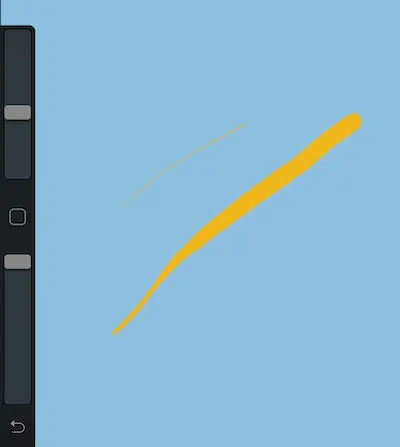
This is really great, but it can also be confusing because of two of Procreate’s other features: it’s opacity slider and brush size slider. Through Procreate, you can adjust your strokes both through your stylus’ pressure and the opacity slider and brush size slider.
The tricky thing is that you can use them both at the same time. This isn’t a problem for pencils that don’t balloon when you push on them, but they can be confusing for markers. You set your brush to a certain size, but then you push too hard and the brush size expands. You then go for a thin line, but because you aren’t pushing very hard, it comes out very light. Goodness gracious.
Personally, I don’t mess with the opacity bar very much. I use pencils with Procreate a lot, so I do find the brush size slider useful. It can get confusing when I switch over to paints or markers though.
It’s actually pretty great that Procreate and other digital art platforms give you so many ways to customize and manipulate your brushes. It just takes some learning and trial and error to get used to.
Digital Art IS Easier Than Traditional Art for Erasing
Digital art is easier than traditional art when erasing your work. With traditional art, you can’t erase permanent mediums. Even pencils can leave marks behind. With digital art, you can erase everything without leaving a trace, which makes it easier to take risks and experiment with your art.
The Moral of the “Why is Digital Art so Hard” Story
At the end of the day, digital art is so hard because it’s different. Even if we jump into digital art knowing that it’s going to be challenging, we don’t usually view it as starting at square one.
We’re artists. It’s art. Right? Right?!
Any of us who have jumped into digital art have learned the hard way that there are some traditional methods that transfer over and some that don’t. We also learned that many of the amazing digital artists that we admire have mastered skills we didn’t even know existed. Basically, digital art is a completely different beast than traditional art.
Yes, digital art is more difficult than traditional art for those with more skill and practice with traditional art. But, traditional art is more difficult than digital art for those with more skill and practice with digital art. It depends on the game we’re used to playing.
A lot of the confusion about whether digital art is harder than traditional art or not comes from thinking that they’re equivalent things.
Yes, there are some similarities and carryovers between the two, but they’re basically two completely different skill sets. In the same way that a pro softball player can’t expect to instantly be a pro baseball player, digital art and traditional art are too similar styles that have a lot of different nuances.
Think about digital art as a completely separate thing than traditional art and it will help with your digital art learning curve.
Instead of banging your head against your tablet trying to figure out why the paint doesn’t function exactly like real world paint, you’ll be open to the idea that things work differently in this digital world. Basically, you’ll be more willing and able to learn. But how, exactly? Let’s talk about that next.
How to Learn Digital Art
There’s a lot of value to formally learning digital art. This doesn’t mean you need to get a degree in it or anything, but you’ll gain a lot by doing more than just experimenting with different tools and settings. Getting a strong foundation in the basics of whatever platform you choose will take you a long way and speed up your learning curve.
If you’re hoping to dive into either Procreate or Illustrator, my suggestion is Skillshare. Skillshare offers TONS of expert-led classes on everything you’ll need to know to effectively use these programs, from beginning to advanced.
I actually learned my foundational Procreate skills through Skillshare and really enjoyed it. I didn’t feel like I was learning something challenging or difficult at all. The teachers on Skillshare have a knack for breaking up topics into bite sized pieces that are really easy to manage and conquer.
They’re also professionally made and nice to watch. Not to mention that these teachers are some of the top experts in their fields and they often teach you how to recreate one of their pieces of work with some neat tips and tricks you wouldn’t learn elsewhere. Yep, it’s pretty great.
Taking a class can do wonders for your digital art skills. It gives you a step-by-step way to improve your skills and feel like you’re in a community doing so. It can feel really lonely in that digital sea of amazing Procreate features. Get an expert-guide on your team through Skillshare and you’ll see a huge improvement to your motivation and skill set.
Digital art and traditional art are both hard, just in different ways. They are both really fun, just in different ways. If one or the other is giving you a challenge, that’s great. It just means that you’ll have some great rewards coming your way once you figure it out. Jump into a class and see how you can work on your skills and improve, digital or traditional. Whatever you choose, just have fun and make art!

Diana has been an artist for over 27 years and has training in drawing, painting, digital drawing and graphic design. Diana’s latest obsession is digitally drawing with Procreate and Procreate Dreams. Diana has experience selling her art across a number of platforms and loves helping other artists learn how to make money from their art as well.

